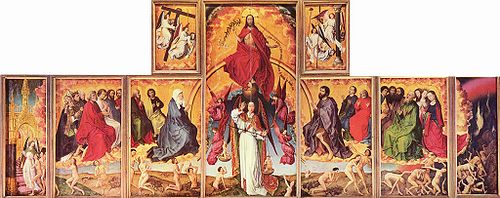.gif)
The Last Judgment (Rogier van der Weyden)
Encyclopedia

Polyptych
A polyptych generally refers to a painting which is divided into sections, or panels. The terminology that follows is in relevance to the number of panels integrated into a particular piece of work: "diptych" describes a two-part work of art; "triptych" describes a three-part work; "tetraptych"...
painted c. 1445–1450 by Rogier van der Weyden. The medium is oil on oak panel
Panel painting
A panel painting is a painting made on a flat panel made of wood, either a single piece, or a number of pieces joined together. Until canvas became the more popular support medium in the 16th century, it was the normal form of support for a painting not on a wall or vellum, which was used for...
, though some panels have been transferred to canvas. It is in the collection of the Musée de l'Hôtel-Dieu, Beaune in France.
Description
At the top ChristChrist
Christ is the English term for the Greek meaning "the anointed one". It is a translation of the Hebrew , usually transliterated into English as Messiah or Mashiach...
sits in judgement, a sword to his left, a lily to his right. Beneath the lily is written in white venite benedicti Patris mei possidete paratum vobis regnum a constitutione mundi. Beneath the sword is written in black discedite a me maledicti in ignem aeternum qui paratus est diabolo et angelis eius. Both are quotations from Jesus' discourse on The Sheep and the Goats
The Sheep and the Goats
The Sheep and the Goats or "The Judgment of the Nations" was a discourse of Jesus recorded in the New Testament. It is sometimes characterized as a parable, although unlike most parables it does not purport to relate a story of events happening to other characters.One explanation is that it tells...
.
Employing iconographic elements common to paintings of the Last Judgment
Doom (painting)
A Doom is a traditional English term for a painting or other image of the Last Judgment, an event in Christian eschatology. Christ judges souls, and then sends them to either Heaven or Hell...
, the Archangel Michael
Michael (archangel)
Michael , Micha'el or Mîkhā'ēl; , Mikhaḗl; or Míchaël; , Mīkhā'īl) is an archangel in Jewish, Christian, and Islamic teachings. Roman Catholics, Anglicans, and Lutherans refer to him as Saint Michael the Archangel and also simply as Saint Michael...
, center, weighs the souls. At Michael's feet the dead rise from their graves. Some souls enter Paradise
Paradise
Paradise is a place in which existence is positive, harmonious and timeless. It is conceptually a counter-image of the miseries of human civilization, and in paradise there is only peace, prosperity, and happiness. Paradise is a place of contentment, but it is not necessarily a land of luxury and...
; others, Hell. Paradise is depicted as a gate to a cathedral illuminated with shining light. The people walk calmly towards it clasping their hands in prayer, as an Angel stands by the gate. Hell is depicted as a place of fiery gloom into which the damned tumble screaming and crying.
At either side of the archangel Michael sit the Virgin Mary, John the Baptist
John the Baptist
John the Baptist was an itinerant preacher and a major religious figure mentioned in the Canonical gospels. He is described in the Gospel of Luke as a relative of Jesus, who led a movement of baptism at the Jordan River...
, the twelve Apostles, and other saints not positively identified.
Sources
- Campbell, Lorne. Van der Weyden. London: Chaucer Press, 2004. ISBN 1-90444-9247
- Blum, Shirley Neilsen. Early Netherlandish Triptychs: A Study in Patronage. California Studies in the History of Art, 13. ISBN 978-0520014442

